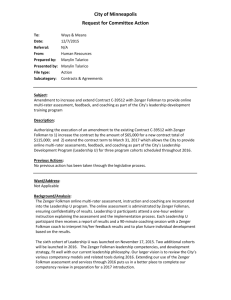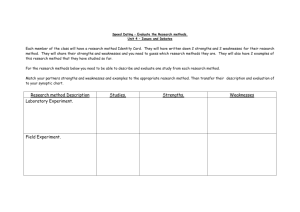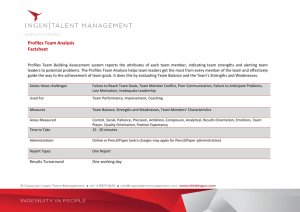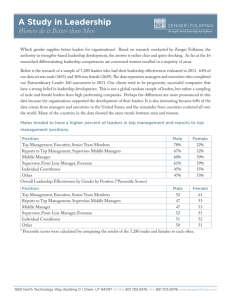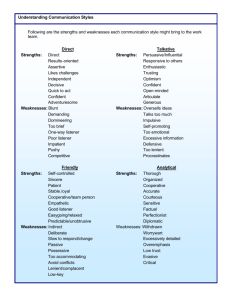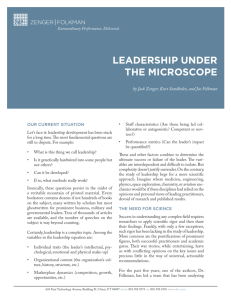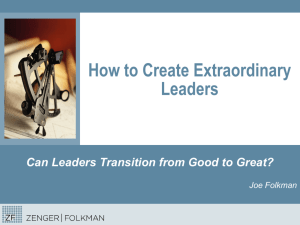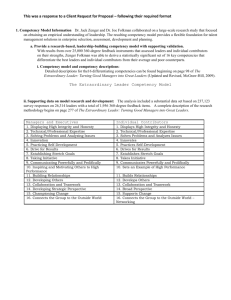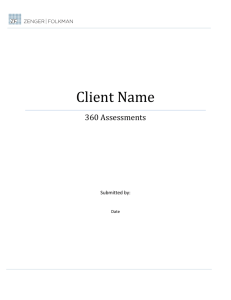turning feedback into change
advertisement
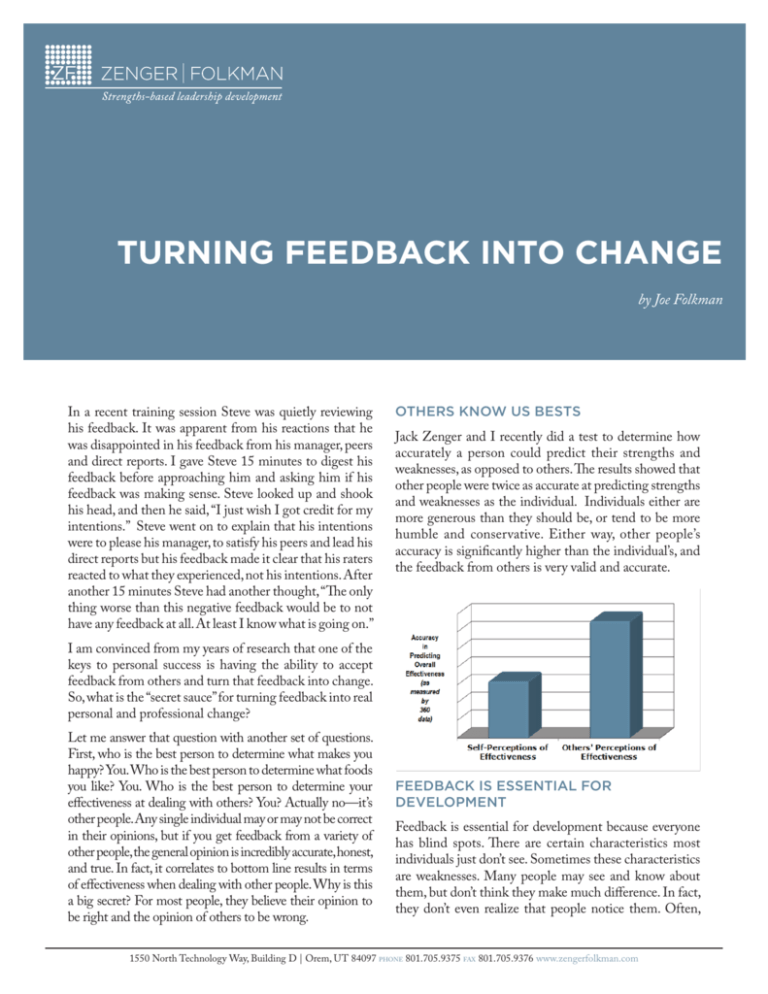
TURNING FEEDBACK INTO CHANGE by Joe Folkman In a recent training session Steve was quietly reviewing his feedback. It was apparent from his reactions that he was disappointed in his feedback from his manager, peers and direct reports. I gave Steve 15 minutes to digest his feedback before approaching him and asking him if his feedback was making sense. Steve looked up and shook his head, and then he said, “I just wish I got credit for my intentions.” Steve went on to explain that his intentions were to please his manager, to satisfy his peers and lead his direct reports but his feedback made it clear that his raters reacted to what they experienced, not his intentions. After another 15 minutes Steve had another thought, “The only thing worse than this negative feedback would be to not have any feedback at all. At least I know what is going on.” OTHERS KNOW US BESTS Jack Zenger and I recently did a test to determine how accurately a person could predict their strengths and weaknesses, as opposed to others. The results showed that other people were twice as accurate at predicting strengths and weaknesses as the individual. Individuals either are more generous than they should be, or tend to be more humble and conservative. Either way, other people’s accuracy is significantly higher than the individual’s, and the feedback from others is very valid and accurate. I am convinced from my years of research that one of the keys to personal success is having the ability to accept feedback from others and turn that feedback into change. So, what is the “secret sauce” for turning feedback into real personal and professional change? Let me answer that question with another set of questions. First, who is the best person to determine what makes you happy? You. Who is the best person to determine what foods you like? You. Who is the best person to determine your effectiveness at dealing with others? You? Actually no—it’s other people. Any single individual may or may not be correct in their opinions, but if you get feedback from a variety of other people, the general opinion is incredibly accurate, honest, and true. In fact, it correlates to bottom line results in terms of effectiveness when dealing with other people. Why is this a big secret? For most people, they believe their opinion to be right and the opinion of others to be wrong. FEEDBACK IS ESSENTIAL FOR DEVELOPMENT Feedback is essential for development because everyone has blind spots. There are certain characteristics most individuals just don’t see. Sometimes these characteristics are weaknesses. Many people may see and know about them, but don’t think they make much difference. In fact, they don’t even realize that people notice them. Often, 1550 North Technology Way, Building D | Orem, UT 84097 PHONE 801.705.9375 FAX 801.705.9376 www.zengerfolkman.com there are also strengths—things that they do incredibly well—but they just don’t realize the leverage and power they possess. Feedback is the most instructive tool to help individuals understand others’ perceptions of themselves— MODEL FOR TURNING FEEDBACK INTO CHANGE IMPROVING THE PROBABILITY OF ACCEPTANCE When I work with leaders who are reviewing the feedback from their 360-degree assessment, sometimes the feedback they receive is quite blunt or negative. Leaders will frequently respond, “I’ve heard that before. I just didn’t think it was that important, so I didn’t do anything about it,” or, “I wasn’t motivated.” Why does this attitude prevail so often? Gene Dalton, a Harvard professor, did a fundamental research project on change and came to the conclusion unless people feel a need to change, they will not change. To turn feedback into change, my colleagues and I at Zenger Folkman use a model consisting of three elements. 1. First is acceptance. People will only change if they example is an alcoholic whose spouse says, “You have not a problem.” Eventually they become divorced and street, and one morning they wake up in the gutter and their change can start. It happens when they accept the feedback and realize that they need to change. 1. Complete Honesty First, they need to be completely honest with themselves. This is the number one skill necessary for accepting feedback. Many people would never tell a lie to another feedback, be honest with themselves, and take it for what it’s worth, is a key characteristic. 2. Concern for Others If individuals don’t care about the person giving feedback, they probably won’t care about the feedback they give. 3. Valuing Differences prioritization. 2. Do you have more to do than you can get done in a day? Are you a little bit overwhelmed in your life? Are you a little frustrated by the amount of things you have time to do? Typically, everyone can answer “Yes” to all three questions. As people think about change, that believe and value the feedback from others who are in the same occupation or have the same gender or race, but likely to accept feedback from others. going to change everything, and the good news is they 4. Optimism that great leaders are great at a few things, but also have weaknesses and are not perfect. In other words, leaders don’t have to be perfect. All they need to do is can do anything with the feedback to change, they will have a hard time accepting it. Remember, people can change. they need to be exceptionally good at. 3. the road. I call it the Process of Change. 5. Listening to Learn listening to form an argument or when people listen to pretend like they care, but they don’t. If a person will listen to learn and really understand where the person giving then their ability to accept feedback will go up substantially. © 2011 Zenger Folkman 2 PRIORITIZING YOUR DEVELOPMENT n te Pas si ce on Com pe The research Jack and I have done reveals that making a substantial change on just one competency or behavior will make a great difference in a person’s development. If people can go from no strengths to possessing just one profound strength, their overall leadership effectiveness will increase from the 34th percentile to the 64th percentile. In other words, they will gain a 30 percentile point rise from just doing one thing well. Taking feedback and focusing one’s effort on a few things is very beneficial, but it is essential to choose the right things to focus on. How does one know which issue is going to have the biggest impact? That’s where the CPO Model comes into play. There are three elements to this model: competence, passion, and organizational needs. O ds Sweet Spot r ga niz a ti o n al N ee 1.Competence When looking at data, try to understand the impact of what Jack and I have termed “fatal flaws” and strengths. A fatal flaw is a competency at the 10th percentile. In other words, it is something you are really bad at. Fortunately, only 30% of the population has them, but if a person has one or more fatal flaws, their average effectiveness rating is usually at the 18th percentile. This flaw can cancel out all the good things that a person does. If an individual has a fatal flaw, their first priority is to fix it. It doesn’t have to be a profound strength, but they do have to get it out of the fatal flaw zone. © 2011 Zenger Folkman If an individual has no fatal flaws, but also has no strengths, their average effectiveness rating is usually at the 50th percentile. The key to becoming great is in developing strengths. When Jack and I observed the best leaders, we found it wasn’t the absence of weaknesses that made them great, but rather the presence of profound strengths. People who have one or more strengths have an effectiveness rating at the 80th percentile. In a recent study I did with General Mills, they looked at a group of leaders who went through The Extraordinary Leader program. Some focused on fixing weaknesses and others concentrated their efforts on building strengths. The study showed those who worked on building strengths improved twice as much as those who focused on fixing weaknesses. The reason why? They were doing something they liked, which leads to the next piece of the CPO model: passion. 2.Passion People often ask, “Which competency should I choose to work on?” My answer is always the same: “I don’t know.” I can look at the data and determine which competencies are strengths and which are weaknesses, but I can’t tell you what you are passionate about. A key ingredient to the formula of change is passion. If a person can work on something they love and something they are really interested in, the probability of their improving goes up substantially. 3. Organizational Needs What competency or capability would make a big difference in an individual’s ability to be successful in their current job? The preoccupation with weakness often times gets people to focus on things that aren’t as useful. Instead, a person should consider what will help them be the most successful in their job. A lot of people have the desire to 3 be promoted. The key to promotion is doing a great job where you are right now. These are the three important elements people should use to prioritize what to work on. The intersection between these three becomes one’s development “sweet spot”. If they can find behaviors in that “sweet spot” area, their ability to change those behaviors goes up substantially. MAKING CHANGE HAPPEN The third part of the change model is making change happen. There are a variety of levers to help facilitate change. 1. Find the Real Problem People often get feedback that is difficult to understand, such as, “You are a jerk,” or, “You just don’t care.” No one knows where to start on those kinds of issues, and no one knows what to do. Until one gets clarity about why people think “you’re a jerk” and what they are doing to cause them to believe that, they can’t do anything about it. Start by finding the real problem. 2. Move toward Specific Goals When people begin the change process, they will usually get feedback that describes broad areas for development, such as being a “better communicator,” or, being “more open.” None of these give insight into what they specifically need to change. In order to really change an issue, they need to move from a general idea to a very specific depiction of the area to improve. They can start by asking themselves probing questions to determine the specific meaning of broad generalizations. The more specific they can get their area of development—by finding the when, what, where, how, and why—the better off they will be in being able to change it. 3. Build a Support System When people start a change process, they often hide and don’t let other people know they working on changing. Our research is very clear that people who share their action plan and enlist the help of others have a significantly higher probability of improving. © 2011 Zenger Folkman 4. Try It, You’ll Like It (After a While) As people start a new behavior, they usually are not very good at it. In fact, most often they are awful. Doing something new is always hard, and requires a great deal of effort. However, after persisting in that effort, they eventually develop some confidence. The effort lessens and the behavior becomes a habit. When the behavior isn’t so hard and difficult to do, they will become better at doing it naturally. 5. Don’t Get Trapped By Beliefs Everyone forms theories and beliefs about different things or different people or why things are the way they are. These beliefs come out of their experience. They may not all be correct. Sometimes people really need to challenge their basic assumptions about why things are the way they are. 6. Avoid Feeling Deprived As soon as someone starts to diet and decides that they are not going to have a particular food, it’s usually the only thing they want. When people feel deprived, it’s all they focus on because it causes them to obsess about something. A great trick for change is to focus on the benefits of the new behavior as opposed to the deprivation. People should not think about what they can’t do, but rather, think about what they are going to do and why that’s going to be better. 7. Create Structure There are helpful structures that can help us to change. Often, people choose the most difficult things to change and really require the use of helpful structures to facilitate that change. Planners or schedulers, meetings, project plans with milestones, coaches, and systems are all structures that will help people change. 8. Have a Clear Vision As people think about and evaluates their vision, it becomes clearer and they have a better sense of what they want to accomplish and how to do it. When responding to feedback, people often set a goal but don’t have vision. They don’t have clarity about what they want to do, how it’s going to feel, and how they’re going to be different. If people will do things such as select a role model, envision how they are going to change, and visualize how people will perceive their change, it will be easier to succeed. 4 NEXT STEPS FOR CHANGE never asking for feedback. When people ask for feedback, sometimes it is something they don’t want to hear. However, how they react to the feedback is critical. In short, don’t kill the messengers. When you do this, you are, “I appreciate that feedback—tell me more.” If you don’t understand it, you say, “Help me understand that.” Be aware that others tend to tell people what they want to hear. Individuals should thank others for giving honest feedback and, as you thank and reward people, they tend to give feedback more often. Encourage feedback from a variety of people—diversity is important. Involve others in your development and share your plans and goals. Some of the best feedback a person can receive process allows you compare feedback across multiple facilitates honest and candid feedback. Simply put, the key to improving personal success is by turning feedback into change. ZENGER | FOLKMAN empirical research using 360-degree assessments and other surveys, we’ve built one of the world’s largest collections of leadership research data – hundreds of thousands of feedback surveys on tens of thousands of managers. Using powerful techniques that focus on building strengths using implementation tools and personalized coaching, our approach the ways to put it to work within organizations. Zenger Folkman. We welcome the opportunity to talk with you about how your organization can develop extraordinary leaders Joe Folkman, Ph.D., is a frequent keynote speaker and conference presenter, a consultant to some of the world’s most successful Business Employment Weekly, Training and Development, and Executive Excellence. CONTACT US © 2011 Zenger Folkman phone 801.705.9375 email info@zengerfolkman.com internet www.zengerfolkman.com 5

